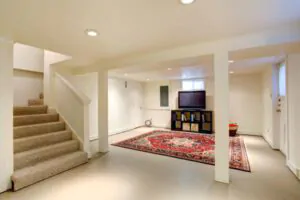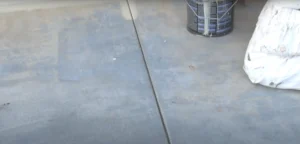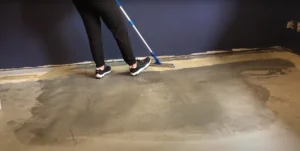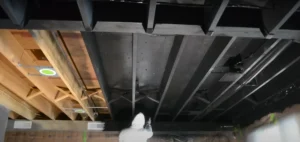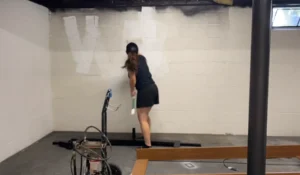Tired of your dark, damp basement? Glass block windows can brighten your space and keep water out. Many homeowners struggle with old, leaky basement windows that let in moisture and pests.
Installing glass block windows can solve these problems and add a touch of style to your home.
Glass block windows are tough and need no upkeep. They let in light while keeping intruders out. This guide will show you how to install glass block windows in your basement. We’ll cover the tools you need, steps to follow, and tips for easy to install glass block basement windows.
Ready to transform your basement? Let’s get started.
Key Takeaways
- Glass block windows brighten basements, keep out water, and need no upkeep.
- Key tools include masonry chisel, pointing trowel, level, and glass block window panels.
- Remove old window, measure opening, set panel on wedges, apply mortar, and seal gaps.
- Small basement windows (25×25 inches) cost $60-$300, while pro installation runs $700-$1,000 per window.
- DIY installation takes about a day and saves money but requires skill and patience.
Tools and Materials Needed
Getting ready to install glass block windows in your basement? You’ll need the right tools and materials for the job. Here’s what you should gather before starting your glass block basement window installation:
- Masonry chisel: Use this to remove old mortar and create clean edges.
- Pointing trowel: Helps apply and shape mortar between blocks.
- Margin trowel: Great for mixing small amounts of mortar and filling gaps.
- Striking tool: Smooths out mortar joints for a clean look.
- Bucket: Mix your mortar in this.
- Caulk gun: Applies sealant around the window frame.
- Circular saw or reciprocating saw: Cuts through old window frames.
- Hammer: Useful for various tasks, including removing old frames.
- Hearing protection: Keeps your ears safe during noisy cutting tasks.
- Level: Ensures your window is straight and plumb.
- Safety glasses: Protects your eyes from debris.
- Stepladder: Helps you reach higher parts of the window.
- Tape measure: For accurate measurements of the current window frame.
- Wrecking bar: Helps pry out old frames and nails.
- Acrylic caulk: Seals gaps around the new window.
- Glass block window: Choose from standard sizes like 14 x 32 inches or 18 x 32 inches.
- Gloves: Protects your hands while working with mortar and glass.
- Mortar mix: You’ll need about half a 60-pound bag for a typical window.
- Wooden wedges: 2-1/2 inches thick at the blunt end and 8 inches long, for leveling.
Step-by-Step Installation Process
Ready to transform your basement? Here’s a step-by-step process of installing glass block basement windows, including tips for a handyman. This guide will walk you through each stage, from removing the old window to sealing the new one in place.
Removing the old window and frame
Removing the old window is the first big step in your glass block project. You’ll need to grab your pry bar and cold chisel. Start by taking out the window jamb. Then, cut through the sill with a saw.
Last, use your chisel to chip away the mortar curb. This part can get messy, so put on gloves and eye protection. Safety first!
Getting rid of the old frame takes time and effort. But it’s key to a smooth install later. Make sure you clear out all the old bits. A clean opening will help your new glass blocks fit just right.
Now, let’s move on to measuring and prepping the space for your shiny new window.
Measuring and preparing the opening
With the old window removed, measure the opening for your new glass block window. Use a tape measure to determine the height and width. For a proper fit, reduce both measurements by 1/2 inch.
This will give you the correct panel size to order.
Now, prepare the opening for your new vinyl window. Remove any debris and ensure the surface is smooth. Apply a half-inch layer of mortar at the bottom to create a level base for your glass block panel.
Keep in mind that large panels can weigh over 100 pounds, so it’s advisable to have assistance when lifting.
Setting the glass block panel in place
Setting the glass block panel is a key step in your basement upgrade. First, cut wedges from a 2×4 to support the panel. Place these wedges on the sill plate. Next, lift the panel onto the wedges and ensure it’s level at the top of the window.
This job is easier with a helper. Center the panel and raise it slightly off the sill. Use more wedges to keep it steady. Custom panels come in many sizes and colors. Pick one that fits your style and space.
Now, you’re ready to secure the panel. Make sure it’s level and plumb before you start. The next step is applying mortar to hold everything in place.
Applying mortar and sealing gaps
Grab your trowel and get ready to apply mortar around your glass block window. Pack the gaps under and beside the panel with care. This step needs patience, as the mortar takes time to set.
On hot days, it might harden in 15 minutes. But in cool weather, it could take over 30 minutes.
After the curb sets, fill any gaps left by wedges. Wait at least two hours before doing this. For a tight seal, use silicone or acrylic latex caulk between the panel and sill plate.
This step keeps water out and makes your basement cozy. With these steps, you’ll have a solid, watertight window in no time.
Final leveling and cleanup
After setting the glass block panel, you’ll need to level it and clean up. Check the panel with a level to make sure it’s straight. If it’s not, adjust the shims and add more mortar as needed.
Once level, let the mortar set for 24 hours. Don’t rush this step – it’s key for a secure installation.
Time to tidy up! Scrape off extra mortar with a utility knife. Wipe down the glass blocks with a damp cloth to remove any smudges. Use a shop vac to suck up loose debris around the window opening.
For a pro finish, seal the top and bottom edges of the panel. Hold off on painting the mortar for at least two weeks. Next, we’ll cover some handy tips to make your glass block window installation a breeze.
Tips for a Successful Installation
Installing glass block windows can be a breeze with the right tips. First, get a buddy to help you lift and place the window. It’s too heavy for one person, and safety comes first.
Next, take your time with measurements. Being off by even a small amount can cause big headaches later. Wait 30 minutes after setting the window before filling shim holes with mortar.
This gives the initial mortar time to set, making for a stronger hold. Lastly, keep your new windows clean and check for cracks in the mortar now and then. A little care goes a long way in keeping your basement bright and dry.
Glass block windows offer many perks for basements. They let in light while keeping prying eyes out. Plus, they’re tough against break-ins and weather. With no moving parts, they need almost no upkeep.
Just wash them now and then to keep them sparkling. If you spot any chips in the mortar, seal them up quickly. This simple step will keep your basement snug and dry for years to come.
Framing Considerations for Basement Windows
Framing basement windows needs care and skill. You must check if your walls are poured concrete or concrete blocks. These materials need different methods for framing. For poured concrete, you’ll need to drill holes and use special anchors.
Concrete blocks might need extra support beams. Make sure the frame fits snugly in the opening. Use pressure-treated wood for the sill plate to stop the rot. Seal all gaps with caulk to keep water out.
This step is key for a dry basement. Don’t forget to add insulation around the frame. It will help keep your basement warm and save on energy bills.
Understanding the Costs: Small Basement Windows
Moving from framing considerations, let’s explore the costs associated with small basement windows. Glass block windows offer a budget-friendly option for basement upgrades.
| Window Size | Price Range | Notes |
|---|---|---|
| 25-by-25-inch | $60 – $300 | Prefabricated panels |
| 48-by-48-inch | $155 – $840 | Larger option |
| Professional Installation is recommended for complex projects like glass block basement windows. | $700 – $1,000 | Per window |
| DIY Installation | Cost of materials | Takes about a day to complete the installation of glass block basement windows. |
Prices vary based on size, quality, and design. DIY installation saves money but requires time and skill. Professional installation costs more but ensures proper fitting and sealing. Factor in tools and materials for a complete budget. Compare prices from different suppliers for the best deal. Investing in quality windows can improve energy efficiency and home value.
Conclusion
Installing glass block windows in your basement can brighten up your space and boost security. With the right tools and a bit of patience, you can tackle this project yourself. Measure carefully, prepare your opening well, and take your time setting the panel.
Be sure to seal gaps properly for a watertight finish. After completion, you’ll enjoy more natural light in your basement while keeping intruders out. Your new glass block window will add value and charm to your home for years to come.
FAQs
1. What tools do I need to install a glass block window in my basement?
You’ll need a hand saw, trowel, mortar, shims, and gloves. A pre-assembled glass block panel or individual glass bricks are key. Don’t forget a metal frame if you’re not using the existing window frame.
2. How do I prepare the space for a new glass block window?
First, take several pictures of the current window. Then, remove the old window and sash. Measure your space carefully. Clean the opening, making it as even as possible. Cut a wood sill plate if needed.
3. What’s the process for installing the glass block window?
Start by applying a thin layer of mortar to the bottom of the opening. Place shims to form a base. Set the pre-assembled panel or build your window with individual glass bricks. Use mortar to secure the sides and top. Pack gaps with mortar.
4. Can I install a glass block window in an existing metal frame?
Yes, you can. Make sure the frame is in good condition. Clean it thoroughly. Apply mortar to the frame before setting the glass block panel. Secure it with more mortar, ensuring it’s flush with the outside.
5. How long does it take for the mortar to set when installing a glass block window?
The mortar should be firm to the touch in about 24 hours. However, it’s best to wait 48 hours before applying pressure to the window. The full curing process can take up to 28 days.
6. Are pre-assembled glass block windows easier to install than individual blocks?
Pre-assembled panels are generally easier and faster to install. They come in a steel frame, ready to fit into your opening. This option is great for DIY home improvement projects. However, individual blocks offer more customization options.

